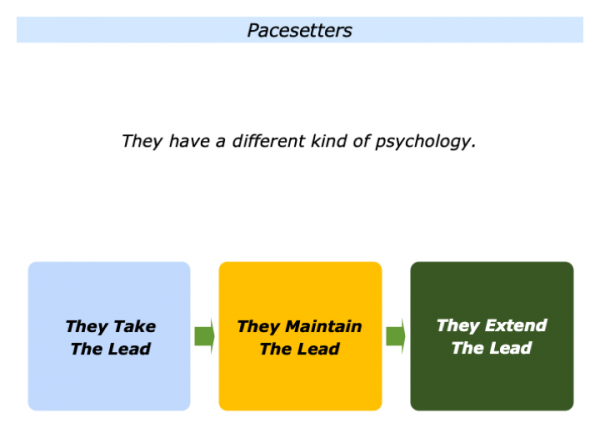
Pacesetters have a different kind of psychology. They take the lead, maintain the lead and extend the lead.
Pacesetters sometimes make the new rules for the game. They create a positive paradigm that shows people a new way of achieving success.
There are many ways to build on your strengths and do pacesetting work in your chosen field. Some people do this by focusing on the following steps.

Positive
Pacesetters have a positive attitude to their work. They often follow a passion where they have the ability to do great work. They love to explore positive possibilities for the future.
Such people take their work seriously but also have a sense of play. Some retain this quality throughout their lives. Play powers our imagination. As George Bernard Shaw wrote:
“We don’t stop playing because we grow old; we grow old because we stop playing.”
Richard Feynman, the professor of physics, urged his students to focus on what they loved to do. This could take them into different dimensions. He kept returning to the following themes.
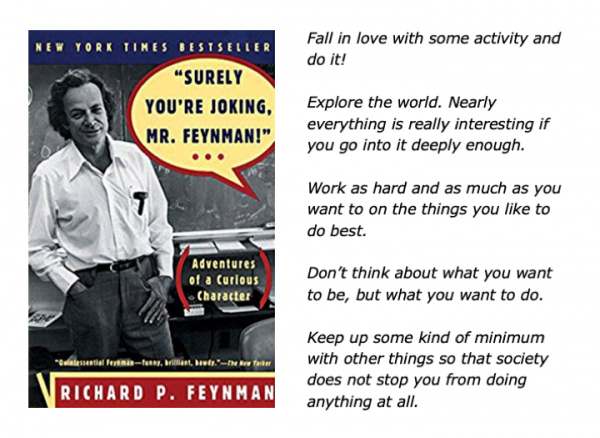
Pacesetters often see patterns and extrapolate what may happen in the future. They visualise how things can be and want to deliver this vision.
Such people are able to see the destination quickly. When entering the situation in which they excel, they quickly see the potential picture of success. They go A, B … and then leap to … Z.
The architect walks onto a site and visualises the finished house. The innovator sees how a piece of technology can transform the world. The mediator imagines a win-win solution for people who are stuck in conflict.
Some people go beyond the first Z. They go onto the second alphabet. Some people go even further. They go into another dimension and onto the third alphabet in their chosen field.
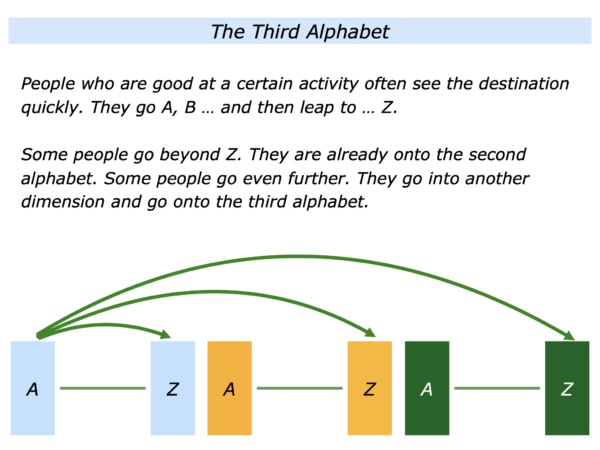
Such people can be inspiring to work with but also challenging. One Chief Operating Officer explained this in the following way.
“Our leader is a real visionary. He sees the future and is years ahead of everybody.
“It is as if he is actually there. He can see, feel and experience what is happening. He can also describe the steps that have been taken to get to this place.
“Whilst a visionary, he can explain some aspects of the journey in great detail. He describes the steps to take and how to overcome challenges. On other occasions, however, he gets exasperated with people who throw in objections.
“He simply says: ‘We can solve that,’ and goes on to explain the vision.
“Many people find him inspiring, whilst other want more detail and get frustrated. My job is to act as a translator. It is to clarify how we can keep running the business whilst also working towards his long-term vision.”
Pacesetters See Possibilities
Pacesetters have a positive approach when faced by challenges in their chosen field. They ask some of the following questions.
What are the possibilities in the situation? What are the potential solutions? What are the opportunities rather than just the obstacles? What are the principles I want to follow? What are the practical solutions? How can I do my best to get positive results?
Such people are often lifelong learners. Everybody is different, but creative thinkers may demonstrate some of the following characteristics.
They developed self-learning skills early in life. They explored through reading, experiences or other methods. They were encouraged to follow their passions or were left alone to adventure.
They explored many different philosophies and the many approaches to life. They may have met different kinds of people or lived in different cultures.
They have learned to see things from different angles. They learned to explore different options without passing judgement. They pursued the things they found fascinating before settling on their chosen specialism.
People who see possibilities aim see the big picture. They look for patterns and connections. They then do deep work on the way towards achieving a compelling goal.
Creative people are sometimes prepared to explore many options without rushing to judgement. They may consider what may seem contradictory ideas and love to keep adding colours to their paintbox. When hearing something, they may ask themselves:
“What if the opposite is true? What happens if I turn the idea upside down? What if I see this as an opportunity rather than an obstacle? What if we turn this so-called limitation into something that is liberating?”
Pacesetters sometimes have what Arie de Geus, the author of The Living Company, called a memory of the future. Such workers anticipate challenges and find potential solutions.
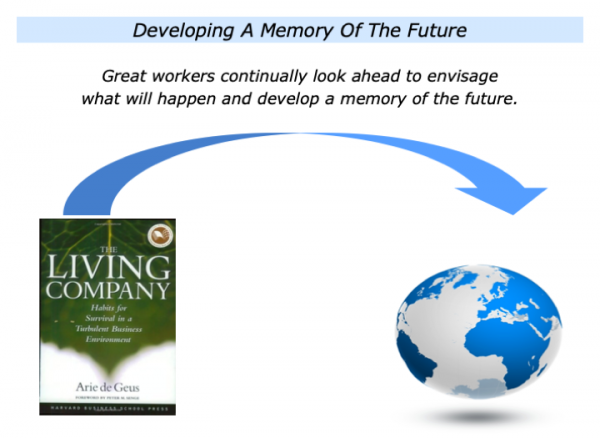
Looking ahead, they use their imagination to take the following steps.
They explore both the positive and challenging scenarios;
They explore how to capitalise on the positive scenarios and how to prevent or, if necessary, manage the challenging scenarios;
They explore the best ways forwards for improving the chances of creating future success.
Such workers find these rehearsals help them as events unfold. Even if the unexpected happens, they will have rehearsed strategies for dealing with many scenarios. This gives them an advantage over others who may not have rehearsed properly.
Such people sometimes go beyond having positive visions. They want to translate these into action. They then focus the next step.
Principles
Pacesetters often follow their chosen principles. The next section looks at people who have done this in different fields.
John Wooden, the legendary American College basketball coach, was a pacesetter who influenced many coaches in sports. He never mentioned winning, but his teams won more titles than any other in College basketball history.
During his early career he began developing his famous Pyramid of Success. This consisted of guiding principles that athletes could put into practise both on and off the court.
The base of the Pyramid consists of phrases such as: Industriousness; Friendship: Loyalty; Cooperation; Enthusiasm. Behind each word there is an explanation. Industriousness, for example, is explained in detail. This includes the phrases:
“In plain language, I mean you have to work – and work hard. There is no substitute for hard work. None. Worthwhile things come only from real work.”
There are several levels to the Pyramid of Success. It culminates in the principle of Competitive Greatness. This is explained as:
“Perform at your best when your best is required. Your best is required each day.”
John Wooden reinforced the Pyramid of Success by using certain maxims to remind people of their responsibilities. These included the following.
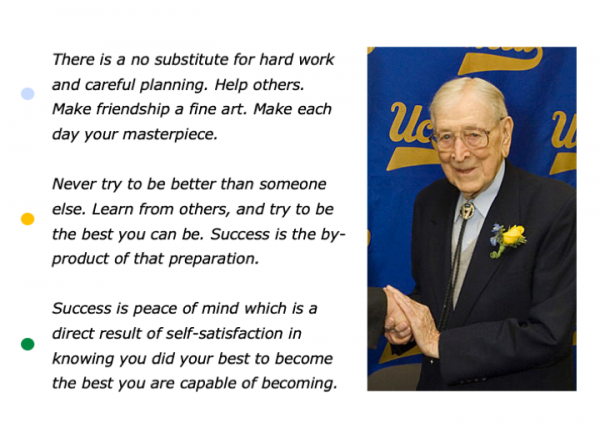
Many people were influenced by his work. Here are two quotes about Coach Wooden. The first is from Bill Walton, a former player.
“(He) has a heart, brain and soul that have enabled him to inspire others to reach levels of success and peace of mind that they might never have dreamed possible on their own.”
The second is from Alan Castel, UCLA assistant professor of psychology, who interviewed Wooden about aging and memory during the summer 2008
“Wooden was a role model, not just as a coach and a wise man, but also for his modesty and character, and on how to age successfully.
“He was a legend in ways that go far beyond basketball. His personality, positivity, wisdom and attitude toward aging played important roles in his cognitive vitality.”
Maria Montessori was a pioneering educator who followed certain principles to help children to develop. She began her career by qualifying as a doctor but then wanted to work as a teacher.
Finding it difficult to get a role in the educational system, she was offered the opportunity to educate children in a mental hospital. Able to work as she wished, Maria created what became known as the Montessori Method.
This produced remarkable results and inspired many other educators to help children to develop. Many people have enjoyed learning in Montessori schools. Some of the famous names include the following.
Anne Frank, the diarist; Gabriel Garcia Marquez, the novelist; Katherine Graham, the former owner-editor of The Washington Post; George Clooney, the actor; Jeff Bezos, the founder of Amazon; Sergey Brin and Larry Page, the co-founders of Google; Jimmy Wales, the founder of Wikipedia.
Many others have supported or taught at such schools. These include: Helen Keller, Alexander Graham Bell, Thomas Edison, Buckminster Fuller, Jean Piaget, the Dalai Lama, Erik Erikson and Nigel Kennedy. Here are some of the themes she followed in her approach to education.
Maria believed in following certain principles to help children to learn. She developed her own philosophy which is allied to the concepts of deep learning and deep work. She expressed this later in the following quotations.
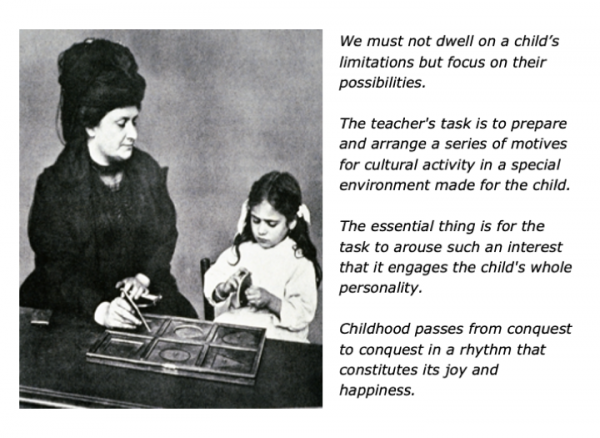
“Our aim is not only to make the child understand, and still less to force him to memorize, but so to touch his imagination as to enthuse him to his innermost core.
“The essential thing is for the task to arouse such an interest that it engages the child’s whole personality.
“It is necessary for the teacher to guide the child without letting him feel her presence too much, so that she may always be ready to supply the desired help, but may never be the obstacle between the child and his experience.”
“The first essential for the child’s development is concentration. The child who concentrates is immensely happy. The first dawning of real discipline comes through work. Every action of the teacher can become a call and an invitation to the children.
“The more the capacity to concentrate is developed, the more often the profound tranquillity in work is achieved, then the clearer will be the manifestation of discipline within the child. Childhood passes from conquest to conquest in a rhythm that constitutes its joy and happiness.”
Pacesetters Can Learn To
Channel Their Personalities
Pacesetters sometimes have personalities that are seen as different. They may be considered to be introverted, highly sensitive, dyslexic or slow learners at school.
Such people can learn to channel their personalities rather than change their personalities. They can learn strategies to survive but these may be different from those needed to succeed when following a conventional route.
Some people who have such qualities are encouraged but others have a more difficult time at school. They may be labelled as dyslexic, having Attention Deficit Disorder or other challenges.
Some find their niche when moving into work. One successful trader I know had synaesthesia, the joining up of senses that are normally separate. They talked about their ability to actually ‘smell a deal’. They followed their nose and delivered the good.
Some people are inventive and create their own field rather than try to succeed in an established field. They may invent a new sport, industry or activity. They then aim to thrive and perform at their best in this new field.
There are many books on the subject of how creative people can learn to develop. The following section describes some ideas outlined in Wired To Create by Carolyn Gregoire and Scott Barry Kaufman.
Here is an excerpt from the official description of the book. This is followed by some characteristics displayed by creative people. These are based on an article that Carolyn Gregoire wrote for the Huffington Post.
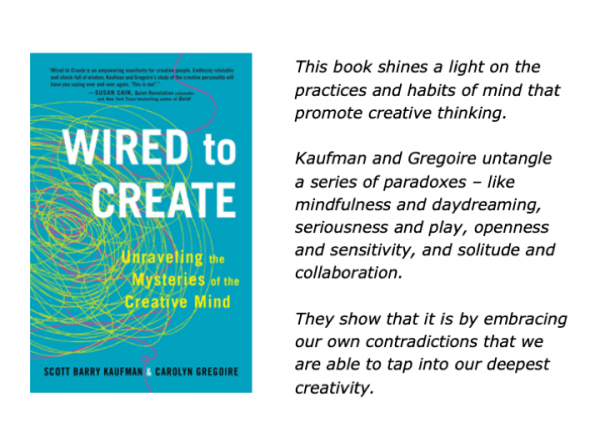
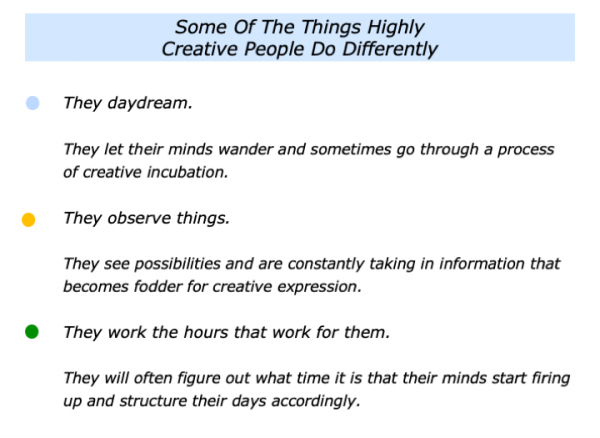
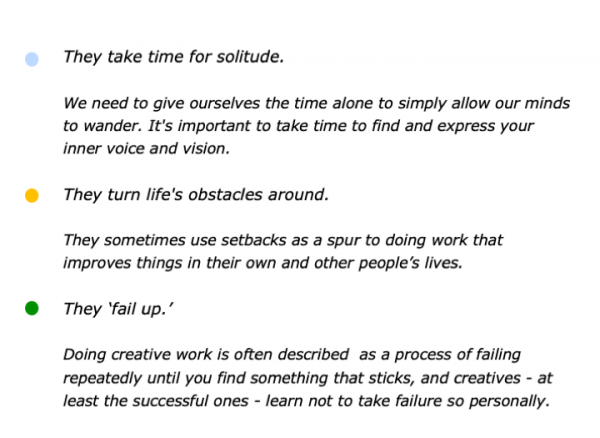
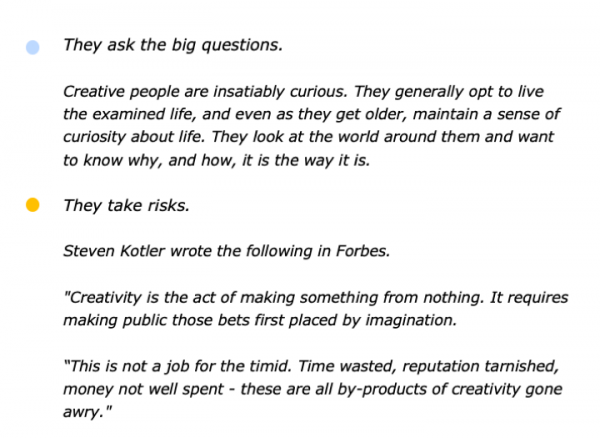
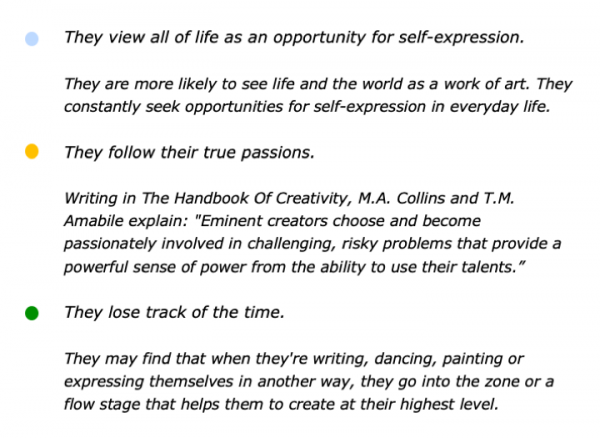
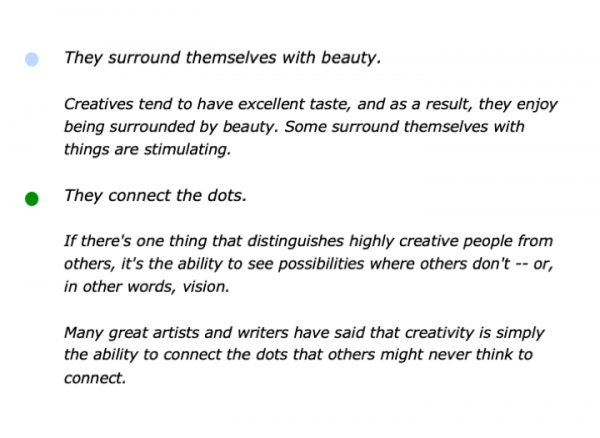
Pacesetters Follow Their
Own Creative Principles
Pacesetters enjoy being creative. Some like to start with a blank piece of paper and lots of resources. This sounds alluring but can lead to paralysis. A person may take a long time to decide what they actually want to create on the blank piece of paper.
Some people prefer to start with the equivalent of borders around the piece of paper. They are then forced to use their imagination to achieve their goals. The borders they are given may include:
The results they aim to deliver … The resources available for delivering the results … The time limits within which they must deliver the results.
Karen Hough described this approach in an article she wrote called Creative Constraint: Why Tighter Boundaries Propel Greater Results. Below is an extract from the article.
It sounds counter-intuitive, but boundaries can actually boost creativity. Think about procrastination — deadlines are often the single factor that ensures projects get done. As Dave Gray commented on his blog:
“Creativity is driven by constraints. When we have limited resources — even when the limits are artificial — creative thinking is enhanced.
“That’s because the fewer resources you have, the more you are forced to rely on your ingenuity.”
When there are no boundaries, the possibilities may seem too large. That’s why some of the greatest art and innovation has come from a situation of constraint.
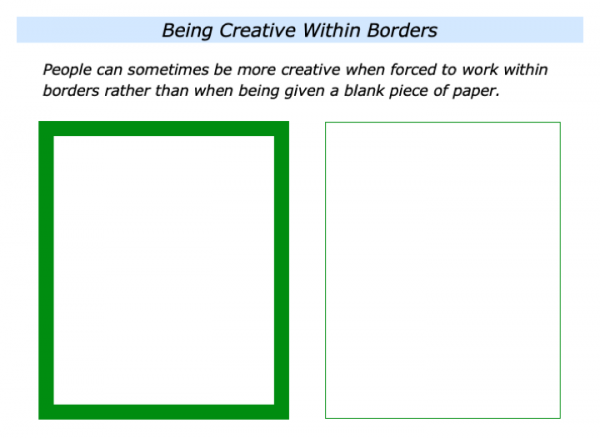
Different pacesetters choose different ways to pursue their chosen route. Some prefer to work alone or run their own businesses. One person expressed this in the following way.
“I spent years working inside organisations trying to persuade people to change. But I was battling against the nature of systems theory.
“Systems move towards homeostasis – the drive to return to their present state. Sometimes this can be good because it creates stability. But sometimes it can be dangerous because it can be a question of develop or die.
“Systems sometimes drive out the creativity they need to survive. So I found other ways to develop new ideas.”
Gordon Mackenzie was somebody who did creative work within an organisation. He described how to do this in his book Orbiting The Giant Hairball: A corporate fool’s guide to surviving with grace.
He spent 30 years working for the Hallmark Card Company and managed to orbit around what he called the hairball of organisational bureaucracy.
Gordon encouraged people to continue to dare, explore and be pioneers. One chapter in his book consists of just one sentence:
“Orville Wright did not have a pilot’s licence.”
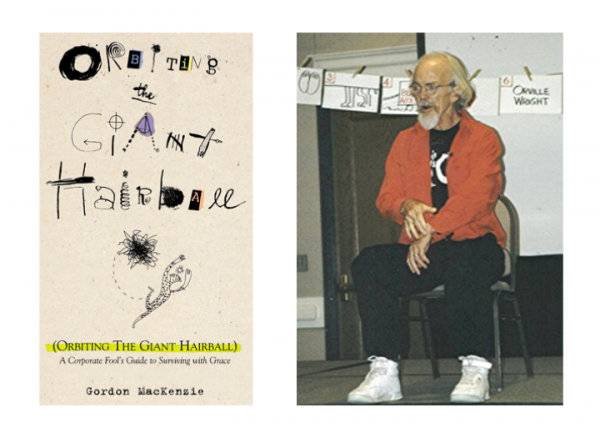
Gordon believed that every person is an artist but the process of suppressing this spirit starts early. During his working career he often spent whole days in elementary schools and asked each group of children the same question. Starting the day in the kindergarten class, he asked:
“Who here is an artist?”
Everybody in the room put their hands up. Many wanted to show their paintings or other creative work they had done. The first grade class responded in a similar way, though with a little more caution.
Gordon continued to ask the question as he worked through the grades. By the end of the day few young people raised their hands. Something had happened to the spark within.
How can a person continue to be an artist? Some people choose to express their talents by being freelancers. Others go into organisations and try to change them from the centre.
Both routes are options, said Gordon, but there is another route. This is to contribute by orbiting around the centre rather than let it cramp your creativity. He explained this in the following way.
“Orbiting is vibrancy. Orbiting is manifesting your originality. It’s pushing the boundaries of ingrained corporate patterns.
“It’s striking a relationship with the corporation so that you can benefit from what it offers – its physical, intellectual, and philosophical resources – without being sucked in by its gravitational pull.
“It’s a symbiotic relationship: without the hairball, the orbiter would spiral into space; without the orbiter’s creativity and originality, the hairball would be a mass of nothing.”
Certainly it is vital to fulfil your obligations to the organisation that pays your wages. At the same time, however, it is important to express your creativity. Here are some quotes from Gordon.
“Everyone has a masterpiece within them from birth. When we are young, society draws pale blue lines, as if your life were a paint-by-numbers kit.
“The message is: If you stay in the lines your life will be a masterpiece. That’s a lie. You have to constantly battle to be nobody but yourself.”
“What is the biggest obstacle to creativity? Attachment to outcome.
As soon as you become attached to a specific outcome, you feel compelled to control and manipulate what you’re doing and in the process you shut yourself off to other possibilities.”
“Creativity is not just about succeeding. It’s about experimenting and discovering. If you go to your grave without painting your masterpiece, it will not get painted. No one else can paint it. Only you.”
Some people find ways to do creative work in organisations but others choose another route. Let’s explore this path.
The Innovation Often Takes Place
Away From The Institution Approach
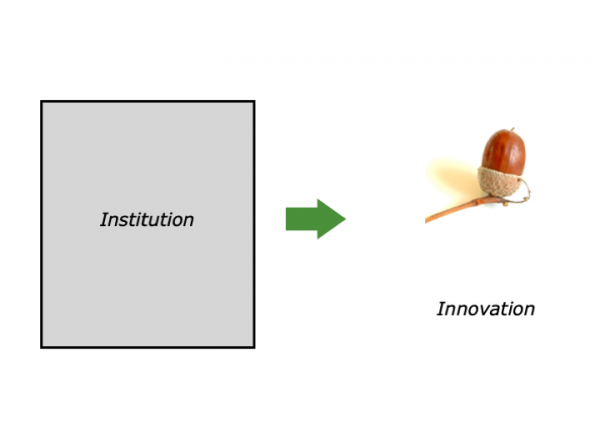
Sometimes it is possible to encourage people to use their imagination within an institution. Many innovators, however, choose to spend time away from institutions.
The institution may be a building, organisation or other body that has an ambivalent attitude towards creative thinking. It can therefore be useful to go beyond such a situation and find other stimulation.
Some innovators may still belong to an organisation but they create some kind of distance. This may be a physical distance – such as working at home or in their own laboratory. Sometimes they aim to create be a psychological distance – such as doing things differently.
Let’s look at one example. Tom was a broadcaster who made compelling films that highlighted problems but also presented positive solutions. His work gained national prominence through regular appearance on television.
Two years after his breakthrough Tom was approached by a national organisation. They gave him the following message.
“We like your innovative ideas and want to hire you to head our organisation. The challenge we face is that we need to revitalise our approach. Unless we do that, we may not be around in five years.”
He admired the institution and chose to take the role. Full of energy at the outset, Tom then ran up against barriers. At this point he and I explored how he could thrive and do good work.
Tom’s strengths lay in certain areas. He believed passionately in improving activities that overlapped with the organisation’s aims. A superb communicator, he also had a track record of making powerful films that brought about change.
The organisation did not seem to understand his strengths. Arriving for the first day at the office, he was given the following message.
“We have mapped out your diary for the first two months. This includes running the Monday morning meetings and taking charge of operations.
“We also want you to dine with our traditional backers in the Shires. They are sceptical of change, but you can win them round.”
Tom launched into fulfilling the schedule but soon because disillusioned, which is when he contacted me. During our first meeting we focused on how to do good work. He soon realised that it was important:
To focus on one area of the organisation’s charter that he believed in and translate this into doing a specific project;
To use his strengths as a broadcaster and communicator to mobilise national attention around this topic;
To show practical ways forward in this area and do his best to deliver positive results.
Tom took this route. He made regular appearances on national television, mobilised public opinion and the project was successful.
His employers were uneasy, however, and issued an ultimatum. They wanted him: a) to energise the organisation; b) to do this in a way that left many of the same things in place.
Tom decided to return to his first love – making compelling films and communicating with the public. He continues to do this and recognised as a respected figure in his field.
The organisation he left remains in a difficult place. Many of its traditional backers are no longer around, so funding is a challenge. It says it wants to follow its principles – which are sound – but has difficulty in applying
Let’s return to your own life and work. Looking ahead, can you think of a situation where you may be more innovative away from an institution?
The institution may be a workplace or a set way of doing things. Both of these can be useful at times because they can provide a framework for doing fine work. It may be that on some occasions, however, you may want to get away from such a familiar setting.
You may want to get stimulation by going for a walk, listening to music, appreciating beauty, being in a different place or having other experiences. There may also be other ways to spark your imagination.
Imagine that want to do a piece of work. You may want to do a creative project, build a successful prototype, shift a culture or do another activity. You may want also want to do work that embodies the following qualities.
Pacesetters Often
Surf The Sigmoid Curve
Charles Handy popularised the term sigmoid curve in his book The Age of Paradox. Originally a mathematical term, it can also be used to track the development of a product, a person’s career, an organisation or even a civilisation.
As one curve reaches its peak, some pioneers aim to create or surf onto the next sigmoid curve. They take this approach rather than lapse into what they see as decline.
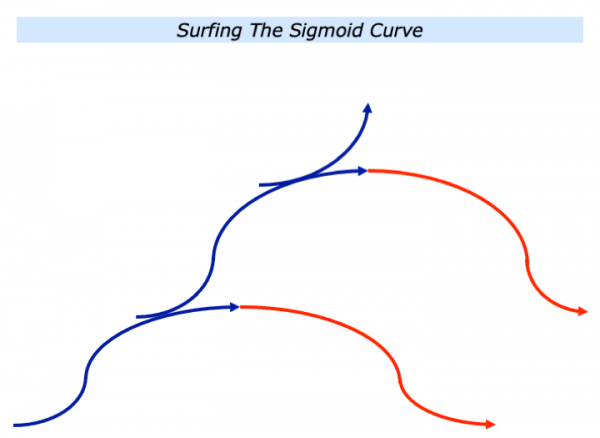
Imagine you are climbing the curve in a specific aspect of your professional life. Where are you now?
Perhaps you are halfway up the curve. Feeling hungry, you may believe there is lots of scope for development. On the other hand, you may have hit a ceiling or believe that your own growth – or the product or service you offer – is deteriorating.
The sigmoid curve approach has implications for businesses. Many companies invest heavily in research. But they make money from the products that have already reached their peak or are in decline.
Sometimes this also calls for employing different kinds of people in different parts of the business. Companies recognise that this can be a challenge. It is vital:
To continue developing new products;
To continue capitalising on the older products that are providing the money for the new developments.
Many people are attracted to creating the new products but the research and development stages seldom brings early returns. It is therefore important to provide encouragement for those who are making money from the older products.
Imagine you are still climbing the curve. How can you keep developing? How can you keep building on your strengths? How can you stay close to your customers and help them succeed?
Surfing Onto The
Next Sigmoid Curve
Imagine that you want to surf onto the next curve. Here are some questions that it may be useful to explore to make this happen.
What are the things that give me positive energy? What are the things that I find fascinating? How can I continue to build on my strengths? How can I do projects that are stimulating?
Looking at my professional life, what will be happening in my field in the next three years? How can I spend time with pacesetting customers and explore the challenges they will face?
How can I stay ahead of the game? How can I create products or services that will help my pacesetting customers and others to succeed? How can I create or surf onto the next sigmoid curve?
Pacesetters Aim To
Deliver Positive Results
Different pacesetters choose different ways to deliver positive results. They may aim to build a successful prototype, pass on their knowledge or offer people a different paradigm.
Anita Roddick was somebody who acted as a role model for people who wanted to build ethical and successful businesses. Whilst it was important that The Body Shop was profitable, she also talked about different definitions of success.
She may have come across as an idealist, but Anita was remarkably savvy. She learned the ‘can do’ attitude from her Italian parents. They ran an American-style Diner café in Littlehampton, Sussex, during the 1950s.
Opening the café at 5.00 am to cater for the fishermen’s breakfast, they kept serving throughout the day until the last customer was satisfied. Anita served in the café from an early age and felt what it was like to handle money.
Gilly Mckay and Alison Cork take up the story in their book The Body Shop. They say that Anita’s apprenticeship proved invaluable when starting her first shop in Brighton in 1976. Here are some quotes from Anita that are in their book.
“When I opened the doors, I was not thinking about changing the world. I simply had to take £1000 in the first week to feed the baby and pay the bills.”
Anita had learned, however, to provide good service that attracted and retained customers. Believing that retail is theatre, she tried to create a good atmosphere in the shop.
“With £4000 borrowed from the bank I could only afford to spend £700 on products. But the 20 products we formulated looked pretty pathetic all standing on one shelf. So to make the shop look busy and full I produced them in five sizes of bottles.
“I couldn’t afford fancy packaging so I bought the cheapest bottles available and the labels were handwritten. We painted the ceiling of our tiny shop green to cover the damp patches and put garden fencing on the walls to stop rain splashing the products.
“The first day we opened was a Saturday and we took £100. The other retailers in the street were laying odds of 10-1 against our surviving six months, but we were on our way.”
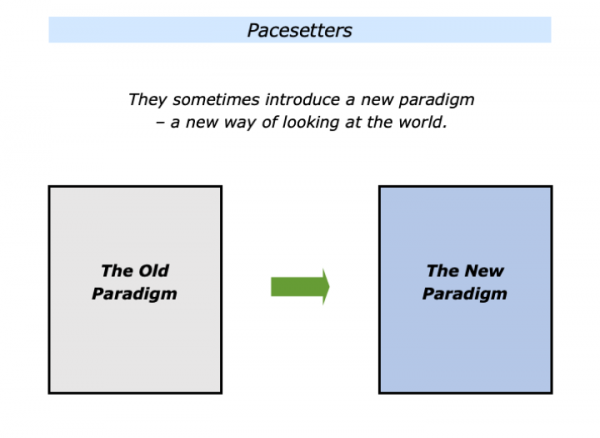
Pacesetters sometimes introduce a new paradigm – a way of looking at the world – that shifts things in a profound way. Such ideas can be transformational and change the rules of the game.
Dick Fosbury created a revolutionary method of high jumping. Sony invented the Walkman. The internet had a profound effect on the way people live, work and do business.
Thomas Kuhn popularised the term paradigm shift in his 1962 article on The Structure of Scientific Revolutions. He explained how breakthroughs in science sometimes come from seeing the world in a different way.
The example that is often quoted is the Earth once being considered the centre of the universe. Seeing that it actually revolves around the Sun enabled people to see reality in a different way.
Pioneers do not subscribe to the cliché of thinking outside the box. They do not actually see a box. They improve things a transformational way and introduce a fresh paradigm. This can sometimes revolutionise whole industries or societies.
This was an approach taken by Buckminster Fuller, the author of Operating Manual For Spaceship Earth. He believed it was vital to show people another way of living, working and sustaining Planet Earth. Bucky believed in the following approach.
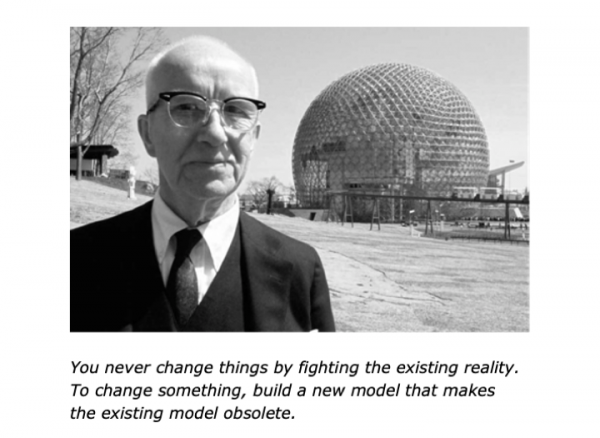
Pacesetters sometimes seem to go into a different dimension to deliver the desired results. They may be playing a sport, performing a song, solving a problem, tackling a challenging or aiming to achieve a specific goal.
They do things that go beyond what others can imagine. They seems to focus on something that only they can see. They then translate this into reality and do something special to deliver the goods.
People who do such things may demonstrate a touch of genius. They then bring to life the often cited quoted by Arthur Schopenhauer.
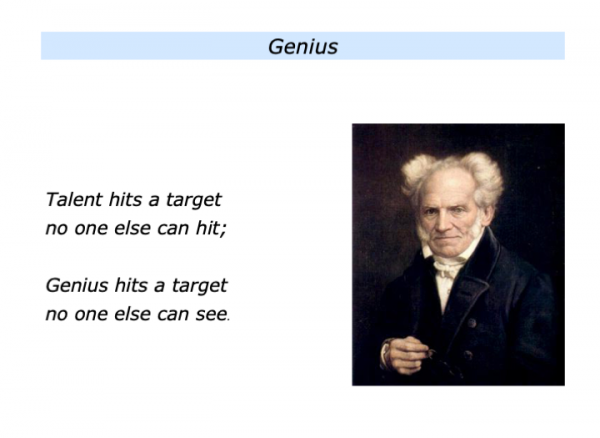
Let’s return to your own life and work. Imagine that you want to follow some elements of the pacesetting approach. How can you do this in your own way?
You may want to do this in the field of counselling, education, health care, business or another activity. You may want to do it when working an individual, a leader or when building a successful prototype.
What may be the piece of work you want to do? How can you deliver this successfully? What will be the benefits of doing such a piece of work – both for yourself and for other stakeholders?
If you wish, try tackling the exercise on this theme. This invites you to complete the following sentences.
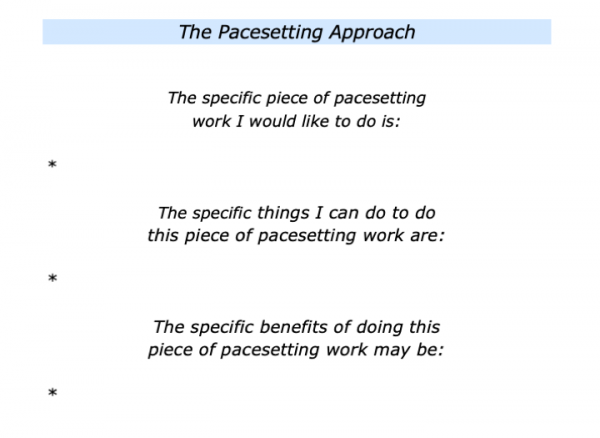






Leave a Reply